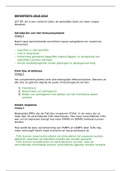Introduction
• Risk = the possibility of an undesirable event resulting from natural events or human
action. It deals with losing something we value (consequence) and uncertainty
(likelihood) → risk = probability x consequences
• A hazard is the possibility of something causing harm, and a risk is the probability of
something causing harm (so when you actually do a possibly harmful action)
• Risk communication definitions:
Any purposeful exchange of scientific information An interactive process of exchange of Communication to
between interested parties regarding health or information and opinions among individuals, improve the public’s
environmental risks, or the act of conveying or groups, and institutions. It often involves ability to make
transmitting information between interested multiple messages about the nature of the appropriate decisions
parties about levels of health or environmental risk, or expressing concerns / opinions, or in view of
risks, or decisions, actions, or policies aimed at reactions to risk messages or to legal and technological
managing or controlling such risks. institutional arrangements for management. hazards.
v
• IRGC framework for risk governance (institutionally dealing with risks):
Pre-assessment: identification and framing (setting the
boundaries of the risk or system)
Appraisal: assessing the technical and perceived causes
and consequences of the risk.
Characterization: whether the risk originates from
natural, technological, economic, or environmental
causes.
Evaluation: making a judgement about the risk and the
need to manage it.
Management: deciding on and implementing risk
management options.
Cross-cutting aspects: communicating/engaging with
stakeholders so they can make informed choices about
risks, balancing evidence-based knowledge with their
own interests, concerns, beliefs, an resources. The
context is culturally dependent and should be considered.
,• Stakeholder engagement, based on the dominant risk characteristic:
• Historical progress of risk communication (Fischhoff):
o Getting the numbers right | telling key publics what the numbers are |
explaining what the numbers mean | showing the public that they have
accepted similar risks before | explaining how the risk benefits outweigh the
costs | treating people with respect and making them partners
• There is increasing attention for systemic risks → reasons:
o Interconnection between different geographical areas and different domains
of society → ripple effect (e.g. risk in agriculture can spread to tourism) //
globalization and urbanization // increase in conflicts // more mobility
• The different forms of risk communication:
o Care communication – informing and educating to stimulate behavioral
change and the taking of safety measures
o Consensus communication - common approach to risk issues in order to
stimulate societal decision making about risk
o Crisis communication – issuing of disaster warnings and emergency info
• Effective risk communication…
o …is not based solely on telling individuals what we want them to know /
increasing their knowledge
o …helps people understand the facts that are truly relevant to their own life, so
that they can make informed decisions
o …should consider and respect factors that can increase or decrease fear, such
as emotion, trust, control, uncertainty, dread, etc.
o …considers both the role of the public and the role of the experts/institutions,
establishing trustworthiness (not asking for trust!)
• Anticipated regret = polar bears going extinct, or missing out on postal code lottery
in your street.
, Risk perception
• Risks are facts, but human behaviour is primarily driven by perceptions.
o Risk perception = perceived probability x perceived consequences
o Risk acceptance = perceived probability x perceived consequences x
importance attached to probability and consequences
• Are we irrational because we are led by perceptions? No, because our rationality is
bounded.
o We have relatively consistent and efficient patterns of perception so that our
mind is not one big chaos // use of heuristics.
o Other reason for bounded rationality: ability and motivation are needed to
process risk information.
o And, people use heuristics.
• With heuristics, people may ignore base-rates (e.g. there are many more truck drivers
than professors). Singular events experienced in person or associated with the
properties of an event are regarded as more typical than information based on
frequency of occurrence.
Slovic’s psychometric studies
• Risk judgments/dimensions
o Among experts: high correlation with technical estimates of annual fatality
rates. If lay people are asked to also use fatality data, they come up with
similar estimates, but lay people choose to focus on other criteria beyond
these rates.
o Among non-experts / lay people: assessment of risk based on two categories:
▪ Unknown factor; observable/unobservable, known/unknown,
immediate/delayed effect, known/unknown to science, new/old risk
• Less concerned when risk is observable, known, immediate
effect, known to science, old risk).
▪ Dread factors; control, catastrophic, impact on future generations,
easy or difficult to reduce exposure, risk increasing or decreasing over
time, (in)voluntary exposure
• Less concerned when risk is controllable, not catastrophic, etc.
• It is vital that risk communication efforts take into account dimensions that are
important to lay people.
Sociodemographics in risk judgments
• White male effect / low risk effect / societal inequality effect: white men, compared
to women and members of minority groups, judge risks as smaller and less
problematic. This is more due to worldviews than race or gender → cultural theory of
risk → white men more often have individualistic and hierarchical worldviews. They
adopt these worldviews to protect their cultural identity. Institutional trust
hypothesis = white men benefit from institutions and may therefore feel safer.










